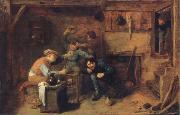Wholesale Oil Painting No Minimum |
|||||||||||
|
|
|||||||||||

|
|||||||||||
|
|
|
||||||||
BROUWER, AdriaenFlemish Baroque Era Painter, ca.1605-1638 Adriaen Brouwer (1605, Oudenaarde - January 1638, Antwerp) was a Flemish genre painter active in Flanders and the Dutch Republic in the seventeenth century. At a young age Brouwer, probably born as Adriaen de Brauwer, moved perhaps via Antwerp to Haarlem, where he became a student of Frans Hals alongside Adriaen van Ostade. He also was active in stage acting and poetry. He stayed in Haarlem and Amsterdam until 1631, when he moved back to Antwerp in the Spanish Netherlands. There, he became a member of the Guild of St. Luke in 1631 ?C 1632, as well as the rhetoricians's chamber De Violieren. Tradition has it that Brouwer himself spent much time in the alehouses of Flanders and Holland. His works are typically detailed and small, and often adopt themes of debauchery, drunkenness and foolishness in order to explore human emotions, expressions and responses to pain, fear and the senses. The Bitter Tonic (illustrated right) is an example of the type of work that depicts such responses, in this case the sense of taste. His work was well liked, to the point that forgeries were sold in his own time. Both Rubens and Rembrandt owned a number of his works. Nevertheless, Brouwer appeared in financial trouble throughout his life. He died at the early age of 32 in Antwerp, where he was first buried in a common grave, but, upon instigation of the members of the guild, was reburied on Feb 1, 1638 in the church of the Carmelites. |
||||||||
|
|
||||||||
Card players quarrelling
Card players quarrelling Painting ID:: 35351 |
mk101
Oil on panel
31.1x49.4cm
mk101 Oil on panel 31.1x49.4cm |
|||||||
|
|
||||||||
|
Jan Steen Dutch Baroque Era Painter, ca.1625-1679 Daily life was Jan Steen's main pictorial theme. Many of the genre scenes he portrayed are lively to the point of chaos and lustfulness, even so much that a Jan Steen household, meaning a messy scene, became a Dutch proverb (een huishouden van Jan Steen). Subtle hints in his paintings seem to suggest that Steen meant to warn the viewer rather than invite him to copy this behaviour. Many of Steen's paintings bear references to old Dutch proverbs or literature. He often used members of his family as models. Jan Steen painted also quite a few self-portraits, in which he showed no tendency of vanity. Steen did not shy from other themes: he painted historical, mythological and religious scenes, portraits, still lifes and natural scenes. His portraits of children are famous. He is also well known for his mastery of light and attention to detail, most notably in textiles. Steen was prolific, producing about 800 paintings, of which roughly 350 survive. Steen's work was valued much by contemporaries and as a result he was reasonably well paid for his work. He did not have any students, but his work proved a source of inspiration for many painters. Card players quarrelling mk101 1664 Oil on canvas 67.7x80.3cm |
||||||||
|
|
||||||||
|
Prev Next
|
||||||||
|
|
||||||||
|
Related Paintings to Jan Steen :. |
||||||||
|
|
||||||||
|
CONTACT US |

